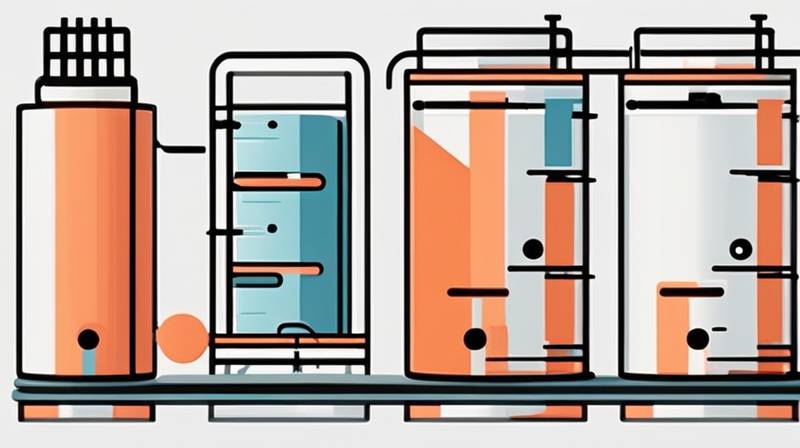
The heating temperature of the energy storage tank can vary depending on several factors. 1. The optimal temperature typically ranges from 120°F to 160°F (49°C to 71°C), 2. This range is chosen to maximize efficiency while reducing heat loss, 3. It is crucial to maintain proper temperature settings to ensure system performance, 4. The design and purpose of the tank may also dictate specific temperature requirements.
1. UNDERSTANDING ENERGY STORAGE TANKS
Energy storage tanks serve an essential role in various heating systems, particularly in commercial and residential settings. They store thermal energy obtained from different sources such as solar panels, boilers, or heat pumps. By maintaining appropriate temperatures within these tanks, it is possible to optimize energy use and enhance system efficiency. The precision of temperature control is vital, as it directly influences the performance and reliability of the heating system.
The design of energy storage tanks varies based on their intended application and the energy source utilized. Tanks can be found in various shapes, sizes, and insulation materials, which impact heating efficiency. Insulation quality is critical, as it reduces heat loss and conserves stored energy, thus allowing the tank to maintain desired temperatures over extended periods. Efficient insulation materials, such as polyurethane foam, can significantly optimize performance by minimizing thermal bridging and convection losses.
2. FACTORS AFFECTING HEATING TEMPERATURE
Multiple factors influence the ideal settings for heating temperatures in energy storage tanks. One of the primary contributors is the intended usage of the stored energy. For instance, domestic hot water applications typically require the tank to maintain temperatures around 140°F (60°C) to effectively combat harmful bacteria such as Legionella. Conversely, industrial applications may demand higher temperatures to accommodate different processes or machinery requirements.
The energy source used for heating also impacts temperature settings. A solar heating system might necessitate different temperature ranges compared to conventional gas or electric systems. For example, solar systems generally perform optimally within lower temperature bands to avoid heat loss and degradation of system components. Conversely, gas heating systems may require higher temperatures to achieve rapid heating and ensure consistent supply.
3. ENERGY EFFICIENCY CONSIDERATIONS
Establishing the right heating temperature for energy storage tanks is not merely a matter of operational efficiency; it also bears considerable environmental impacts. Maintaining appropriate temperature settings can lead to substantial energy savings. For example, by reducing the thermostat setting in those cases where extremely high temperatures are not necessary, users can significantly decrease energy consumption.
Moreover, the implementation of smart technology can further enhance temperature management. Advanced thermostats and automation systems can optimize heating and cooling patterns to adapt to changing environmental conditions or consumption needs. These technologies can analyze historical usage data, predict demand fluctuations, and adjust temperatures accordingly to minimize energy depletion while maximizing system performance.
4. MAINTAINING OPTIMAL TEMPERATURE
To achieve optimal temperature regulation, regular inspections and maintenance of energy storage tanks are essential. Components such as thermostats, valves, and heating elements should be consistently checked for functionality and efficiency. An underperforming element could lead to unnecessary heat loss, hindering the system’s ability to maintain desired temperatures.
Additionally, conducting routine maintenance can prevent unforeseen breakdowns and prolong the lifespan of the tank and associated systems. This includes flushing the system to remove sediments, checking for leaks, and ensuring that insulation remains intact and effective. By staying proactive with maintenance, users can significantly enhance operational reliability while decreasing long-term energy costs.
FREQUENTLY ASKED QUESTIONS
WHAT IS THE IDEAL HEATING TEMPERATURE FOR ENERGY STORAGE TANKS?
The ideal heating temperature for energy storage tanks typically falls within the range of 120°F to 160°F (49°C to 71°C). This range accommodates various applications, balancing efficiency and safety. For systems designed to heat water for domestic use, a lower temperature closer to 140°F is generally sufficient to prevent bacterial growth while providing adequate hot water supply. For industrial applications or specific heating demands, higher temperatures may be necessary. It’s essential to consider the specific requirements of the system and consult manufacturer guidelines for optimal performance.
HOW DOES INSULATION AFFECT HEATING TEMPERATURE?
Insulation plays a critical role in maintaining the heating temperature within energy storage tanks. Effective insulation materials minimize heat loss and ensure that the operating temperature remains consistent over time. The thickness and quality of the insulation material will directly impact the amount of energy required to maintain the desired temperature. High-quality insulation not only enhances efficiency by reducing energy consumption but also prevents overheating risks and associated failures within the heating system.
CAN SMART TECHNOLOGIES IMPROVE TEMPERATURE MANAGEMENT?
Certainly, smart technologies can substantially enhance temperature management in energy storage tanks. Employing advanced thermostats, automation systems, and energy management software allows for real-time monitoring and adjustments based on usage patterns. These technologies can predict demand fluctuations and optimize the heating cycles, consequently reducing energy waste. By integrating smart controls, users can achieve more precise temperature regulation, reduce operational costs, and align energy use with specific needs for improved efficiency and convenience.
Maintaining the right temperature in energy storage tanks is a multifaceted process that encompasses various considerations. The interplay between usage requirements, insulation efficiency, and technological advancements plays a vital role in achieving optimal performance. Attention to temperature management not only enhances system longevity but also significantly reduces energy costs and environmental impact. Proper temperature settings safeguard against issues such as inefficient energy use and potential system failure, creating a win-win scenario for both consumers and the environment. In today’s conscientious society, understanding these principles is crucial for any user of energy storage systems. Therefore, investing in quality insulation, pursuing regular maintenance, and exploring smart technology options will provide a comprehensive approach to managing energy storage tank performance effectively. Consistent education about energy efficiency practices will amplify benefits across the board, promoting sustainability while also yielding tangible savings in operation.
Original article by NenPower, If reposted, please credit the source: https://nenpower.com/blog/what-is-the-heating-temperature-of-the-energy-storage-tank/


